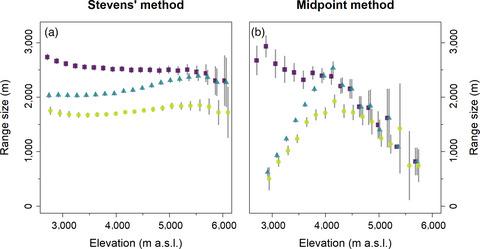Our official English website, www.x-mol.net, welcomes your
feedback! (Note: you will need to create a separate account there.)
Elevational range size patterns of vascular plants in the Himalaya contradict Rapoport's rule
Journal of Ecology ( IF 5.3 ) Pub Date : 2021-08-25 , DOI: 10.1111/1365-2745.13772 Martin Macek 1, 2 , Miroslav Dvorský 1 , Martin Kopecký 1, 3 , Jan Wild 1, 4 , Jiří Doležal 1, 5
中文翻译:

喜马拉雅山维管植物的海拔范围大小模式与拉波波特规则相矛盾
更新日期:2021-08-25
Journal of Ecology ( IF 5.3 ) Pub Date : 2021-08-25 , DOI: 10.1111/1365-2745.13772 Martin Macek 1, 2 , Miroslav Dvorský 1 , Martin Kopecký 1, 3 , Jan Wild 1, 4 , Jiří Doležal 1, 5
Affiliation

|
- Elevational range size patterns reflect ecological and evolutionary processes, but they are also affected by geometric constraints. The confounding effect of these constraints led to an ongoing controversy about the elevational Rapoport's rule, which postulates a positive association between the range size and elevation, and about the plausibility of the climate variability hypotheses as its causal explanation.
- Here we used an advanced null modelling approach to disentangle the interacting effects of geometric constraints and species richness gradients on the elevational range size of vascular plants. We collected extensive field data on elevational distribution for 728 vascular plant species occurring in the Ladakh region, Western Himalaya. We supplied these regional data with subcontinental elevational ranges extracted from the literature. Moreover, we used in situ measured temperatures to quantify temperature variability along an elevational gradient to test the climate variability hypothesis.
- Observed range size patterns were sensitive to methods used to quantify the average range size. Range truncation disproportionately affected regional ranges of low-elevation species and resulted in spurious support of elevational Rapoport's rule. However, when the confounding effects of domain boundaries and richness gradient were controlled, our null models revealed only slight deviations from the random expectations of elevational range size patterns, contrasting with the prediction of the Rapoport's rule. In line with these findings, seasonal and diurnal temperature variability did not change with elevation.
- Synthesis. Geometric constraints combined with underlying species richness gradient create range size patterns seemingly supporting Rapoport's elevational rule. However, null models accounting for these effects indicate that the range size of vascular plants in the Himalayas does not increase with elevation. Given the universality of the geometric constraints and species richness gradient, our results suggest that these confounding factors must be controlled when testing Rapoport's rule. The null model approach described here provides an efficient tool to do that.
中文翻译:

喜马拉雅山维管植物的海拔范围大小模式与拉波波特规则相矛盾
- 海拔范围大小模式反映了生态和进化过程,但它们也受到几何约束的影响。这些限制的混杂效应导致了关于海拔 Rapoport 规则的持续争议,该规则假设范围大小和海拔之间存在正相关,以及气候变率假设作为其因果解释的合理性。
- 在这里,我们使用先进的零建模方法来解开几何约束和物种丰富度梯度对维管植物海拔范围大小的相互作用影响。我们收集了有关喜马拉雅西部拉达克地区 728 种维管植物物种海拔分布的大量实地数据。我们提供了这些区域数据以及从文献中提取的次大陆海拔范围。此外,我们使用原位测量温度来量化沿海拔梯度的温度变化,以测试气候变化假设。
- 观察到的范围大小模式对用于量化平均范围大小的方法敏感。范围截断不成比例地影响了低海拔物种的区域范围,并导致对海拔拉波波特规则的虚假支持。然而,当域边界和丰富度梯度的混杂影响得到控制时,我们的空模型仅显示出与高程范围大小模式随机预期的轻微偏差,与 Rapoport 规则的预测形成对比。与这些发现一致,季节性和昼夜温度变化不随海拔变化而变化。
- 合成。几何约束与潜在的物种丰富度梯度相结合,创造了似乎支持 Rapoport 的海拔规则的范围大小模式。然而,考虑到这些影响的空模型表明,喜马拉雅山维管植物的范围大小不会随着海拔的升高而增加。鉴于几何约束和物种丰富度梯度的普遍性,我们的结果表明在测试 Rapoport 规则时必须控制这些混杂因素。这里描述的空模型方法提供了一种有效的工具来做到这一点。











































 京公网安备 11010802027423号
京公网安备 11010802027423号